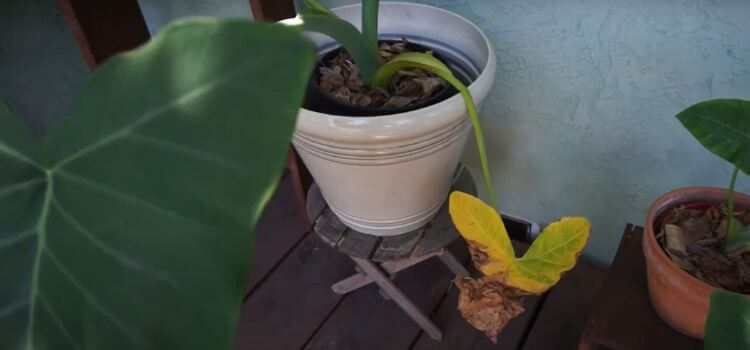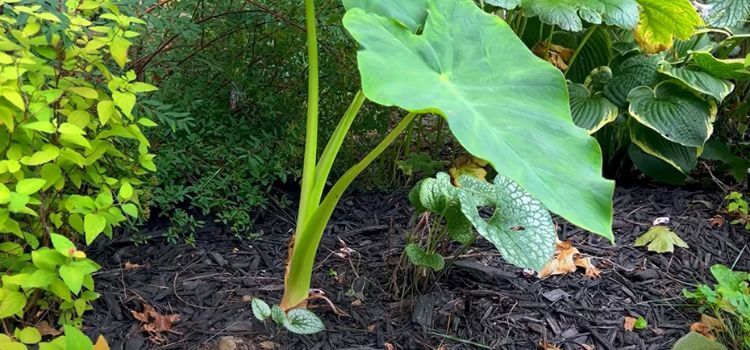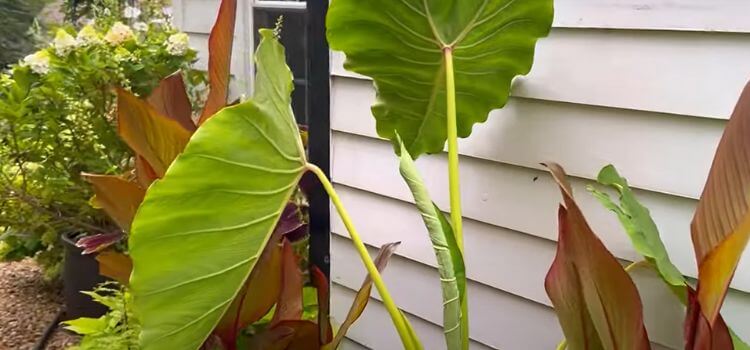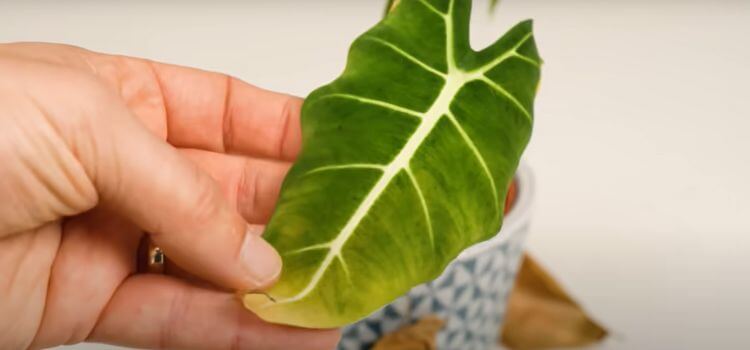As an Amazon Associate, I earn from qualifying purchases.
Elephant ear plants turning yellow can indicate overwatering, underwatering, or nutrient deficiencies. Check soil moisture and provide proper care.
Elephant ear plants are famous for their large, striking leaves. They thrive in warm, humid environments and require regular care. Yellowing leaves often signal an issue with watering practices. Overwatering can lead to root rot while underwatering stresses the plant.
Nutrient deficiencies also cause discolouration. Ensure soil remains consistently moist but not soggy. Proper fertilization and adequate light are crucial. Monitor your plant’s conditions and adjust care routines accordingly. Prompt attention helps maintain their vibrant, healthy appearance. Recognizing and addressing the underlying issues early can prevent further damage and promote lush growth.
Causes Of Yellowing Elephant Ear Plants
Elephant Ear Plants are famous for their large, lush leaves. These plants can sometimes turn yellow, causing concern for gardeners. Understanding the causes of yellowing leaves can help keep plants healthy and vibrant.

Inadequate Water
Elephant Ear Plants need the right amount of water. Too little or too much water can cause yellow leaves. Here are some signs of inadequate watering:
- Dry soil: If the soil feels dry, the plant needs water.
- Drooping leaves: Leaves may droop if they do not get enough water.
- Yellow tips: The tips of the leaves can turn yellow.
To avoid these issues, water your plants regularly. Use the following tips:
- Check soil moisture: Use a moisture meter to check the soil.
- Water deeply: Water the plant until the soil is moist but not soggy.
- Adjust watering schedule: Water more often in hot weather and less in cool weather.
Excessive Sunlight Exposure
Elephant Ear Plants thrive in bright, indirect light. Too much direct sunlight can cause the leaves to turn yellow. Look for these signs of sun damage:
- Scorched leaves: Leaves may look burnt or crispy.
- Yellow patches: Patches of yellow can appear on the leaves.
- Wilting: The plant may wilt in strong sunlight.
To protect your plants from excessive sunlight, follow these steps:
- Provide shade: Use a shade cloth or move the plant to a shadier spot.
- Rotate the plant: Turn the plant occasionally to ensure even light distribution.
- Monitor light levels: Use a light meter to check the intensity of sunlight.
Nutrient Deficiencies
Elephant Ear Plants need nutrients to stay healthy. Lack of essential nutrients can cause yellow leaves. Common nutrient deficiencies include:
| Nutrient | Symptoms |
|---|---|
| Nitrogen | Leaves turn yellow from the bottom up. |
| Iron | New leaves turn yellow while veins stay green. |
| Magnesium | Yellow spots appear between leaf veins. |
To prevent nutrient deficiencies, use a balanced fertilizer. Follow these tips:
- Test the soil: Use a soil test kit to check nutrient levels.
- Apply fertilizer: Use a fertilizer designed for Elephant Ear Plants.
- Follow instructions: Always follow the recommended dosage on the fertilizer package.
Pest Infestation
Pests can cause yellow leaves on Elephant Ear Plants. Common pests include spider mites, aphids, and mealybugs. Signs of pest infestation include:
- Small holes: Look for tiny holes in the leaves.
- Sticky residue: Pests may leave a sticky substance on the plant.
- Webbing: Spider mites create webbing on the leaves.
To control pests, use these methods:
- Inspect regularly: Check your plants for pests every week.
- Use insecticidal soap: Spray the plant with insecticidal soap to kill pests.
- Remove pests by hand: Pick off visible pests and dispose of them.
Signs And Symptoms Of Yellowing
Elephant Ear Plants are famous for their large, vibrant leaves. But seeing them turn yellow can be alarming. Yellowing leaves are a sign of distress in these plants. Knowing the signs and symptoms can help you save your plant. Let’s explore the common signs of yellowing in Elephant Ear Plants.
Yellowing Leaves
Yellowing leaves are often the first sign of trouble. Many factors can cause this issue. Common causes include:
- Overwatering: Too much water can lead to root rot.
- Underwatering: Dry soil can stress the plant.
- Poor light conditions: Too much or too little light affects leaf colour.
Overwatering is a significant cause. Roots need air to breathe, and waterlogged soil cuts off the air supply, leading to root rot and yellow leaves. Check the soil before watering. It should be dry an inch below the surface.
Underwatering also stresses the plant. Leaves may turn yellow and fall off. Ensure the soil remains moist but not soggy. Adjust watering based on the season. Plants need less water in winter.
Poor light conditions also impact leaf colour. Elephant Ear Plants need bright, indirect light. Too much direct sunlight can scorch the leaves, and too little light can cause yellowing. Place your plant in a spot with filtered sunlight.
Leaf Drooping
Leaf drooping is another symptom of distress. Like yellowing leaves, drooping can have several causes. Common reasons include:
- Improper watering: Both overwatering and underwatering can cause drooping.
- Temperature stress: Extreme temperatures can affect plant health.
- Pest infestations: Insects can weaken the plant.
Improper watering is a frequent cause. Overwatered plants have weak roots, which causes the leaves to droop. Underwatered plants lack the needed moisture, which causes their leaves to droop due to dehydration. Ensure you water the plant correctly.
Temperature stress affects the plant, too. Elephant Ear Plants prefer warm, humid conditions. Cold drafts or hot, dry air can cause drooping. Keep the plant away from air vents and drafts and maintain a consistent temperature.
Pest infestations weaken the plant. Common pests include spider mites and aphids. Check the leaves for tiny insects. Treat infestations promptly with insecticidal soap or neem oil.
Leaf Discoloration
Leaf discolouration is a sign of nutrient deficiency. Elephant Ear Plants need a balanced diet. Essential nutrients include nitrogen, phosphorus, and potassium. Discoloration can result from:
- Nutrient deficiency: Lack of essential nutrients.
- Soil pH imbalance: Incorrect pH affects nutrient absorption.
- Fungal infections: Diseases can cause colour changes.
Nutrient deficiency is common. Yellow or pale leaves indicate nitrogen deficiency and purple or dark spots signal phosphorus deficiency. Test the soil and fertilize it accordingly. Use a balanced fertilizer to provide all essential nutrients.
Soil pH imbalance affects nutrient uptake. Elephant Ear Plants prefer slightly acidic soil, ideal between 5.5 and 7.0. Test the soil pH and adjust as needed. Add lime to raise the pH or sulfur to lower it.
Fungal infections can also cause discolouration. Common fungi include leaf spots and blight. Infected leaves show dark spots or patches. Remove affected leaves and treat them with a fungicide. Ensure good air circulation around the plant.

How To Properly Water Elephant Ear Plants
Elephant Ear Plants are famous for their large, lush foliage. But seeing their leaves turn yellow can be alarming. Proper watering is essential to keep these plants healthy. Overwatering or underwatering can cause yellowing leaves. Understanding the appropriate watering techniques is critical to maintaining the vibrant green of your Elephant Ear Plants.
Watering Frequency
Consistent watering is crucial for Elephant Ear Plants. They thrive in moist soil but do not tolerate standing water. Here’s a simple guide to help you manage their watering frequency:
- Water the plants every 2-3 days during the growing season.
- Reduce watering to once a week during the dormant season.
- Ensure the soil remains consistently moist but not soggy.
Signs of improper watering include:
- Yellow leaves indicate overwatering or poor drainage.
- Brown leaf edges suggest underwatering or low humidity.
Adjust your watering schedule based on these signs to keep your plants healthy.
Watering Techniques
Using the proper watering techniques can make a big difference. Here are some effective methods:
- Water at the base of the plant to avoid wetting the leaves.
- Use a watering can with a narrow spout for precision.
- Water early in the morning for best absorption.
Avoid common mistakes such as:
- Using cold water, which can shock the plant roots.
- Overhead watering can lead to fungal issues.
Implementing these techniques ensures your Elephant Ear Plants receive the right amount of water without causing stress.
Checking Soil Moisture
Monitoring soil moisture helps prevent overwatering and underwatering. Follow these steps to check soil moisture:
- Insert your finger about 2 inches into the soil.
- If the soil feels dry, it’s time to water.
- If the soil feels moist, wait a day or two before checking again.
Using a moisture meter can also be helpful. This tool provides accurate readings and takes the guesswork out of watering. Keep the following tips in mind:
- Check the soil moisture level at different spots around the plant.
- Ensure the meter is clean for accurate readings.
Regularly checking soil moisture ensures your Elephant Ear Plants get the proper water, keeping them lush and green.
Protecting Elephant Ear Plants From Sunlight
Elephant Ear Plants are known for their large, lush leaves, which can add a tropical feel to any garden. But sometimes, their leaves turn yellow, a sign of too much sunlight. Protecting Elephant Ear Plants from sunlight is crucial to keeping them healthy and green.
Choosing The Right Location
Picking the right spot for your Elephant Ear Plants is very important. These plants need a balance of sunlight and shade. Too much direct sunlight can cause their leaves to turn yellow. Here are some tips for choosing the best location:
- Find a spot that gets morning sun and afternoon shade.
- Avoid places with harsh, direct sunlight all day.
- Plant near taller plants or structures that can provide some shade.
A good location can make a big difference. It helps the plants get just the right amount of light, keeping their leaves green and healthy.
Providing Shade
Sometimes, even the best location may need extra shade. Providing shade can protect your plants from too much sun. Here are some ways to create shade:
- Use a garden umbrella or shade cloth over the plants.
- Place taller plants nearby to cast a shadow.
- Build a simple frame with a fabric to block the sun.
These methods can be very effective. They help to block harsh sunlight and keep the leaves from turning yellow. Shade is crucial for the health of Elephant Ear Plants.
Using Reflective Mulch
Reflective mulch is another excellent way to protect your plants. It helps to reflect sunlight away from the soil and leaves. This keeps the ground cooler and reduces the stress on the plants. Here are some types of reflective mulch you can use:
| Type of Reflective Mulch | Benefits |
|---|---|
| Silver Plastic Mulch | Reflects sunlight and keeps soil cool. |
| Aluminum Foil | Easy to use and very effective. |
| White Plastic Mulch | Reflects light and keeps moisture in the soil. |
Using reflective mulch can be very helpful. It keeps the plants cooler and healthier, prevents the leaves from turning yellow, and keeps your garden looking great.
Addressing Nutrient Deficiencies
Elephant Ear Plants, known for their large, lush leaves, are a gardener’s favourite. But these beautiful plants can sometimes turn yellow, causing concern. One primary reason for this yellowing is nutrient deficiencies. Addressing these deficiencies can bring your Elephant Ear Plants back to their vibrant green colour.
Identifying Nutrient Deficiencies
Yellow leaves are a common sign of nutrient deficiencies in Elephant Ear Plants. Understanding the specific deficiency helps in treating the plant effectively.
Here are some common nutrient deficiencies and their signs:
- Nitrogen Deficiency: Yellowing starts at the tip of the leaf and moves inward.
- Potassium Deficiency: Yellow edges on older leaves, which can also curl.
- Magnesium Deficiency: Yellowing between the veins of older leaves.
- Iron Deficiency: New leaves turn yellow, but veins remain green.
Observing these signs helps in identifying the specific nutrients your plant needs. This is the first step in restoring its health.
Fertilizing Techniques
Proper fertilizing techniques are crucial for the health of Elephant Ear Plants. Correct methods ensure that the plant absorbs nutrients efficiently.
Here are some effective fertilizing techniques:
- Using Liquid Fertilizer: Mix the fertilizer with water and apply it directly to the soil. This method ensures quick absorption.
- Slow-Release Fertilizers: These are granules that release nutrients over time. They are suitable for long-term feeding.
- Foliar Feeding: Spray a diluted fertilizer solution on the leaves. This method provides nutrients directly to the plant.
Each technique has its benefits. Choose the one that suits your plant’s needs and your gardening routine.
Choosing The Right Fertilizer
The type of fertilizer you choose impacts the health of your Elephant Ear Plants. Different fertilizers provide different nutrients.
Here are some options:
| Type of Fertilizer | Benefits |
|---|---|
| Balanced Fertilizer (10-10-10) | Provides equal parts of nitrogen, phosphorus, and potassium. Good for overall growth. |
| Nitrogen-Rich Fertilizer | Boosts leaf growth. Ideal for yellowing caused by nitrogen deficiency. |
| Organic Fertilizer | Improves soil health. Releases nutrients slowly. |
Choosing the right fertilizer ensures that your Elephant Ear Plants receive the nutrients they need to thrive.
Dealing With Pest Infestations
Elephant ear plants are famous for their large, lush leaves. But sometimes, their leaves can turn yellow. This often happens due to pest infestations. Understanding and managing these pests can help save your plants.
Common Pests Affecting Elephant Ear Plants
Several pests can attack elephant ear plants. Here are some of the most common ones:
- Aphids: Tiny insects that suck plant sap.
- Spider mites: Small creatures that weave webs on leaves.
- Mealybugs: White, fluffy insects that gather in clusters.
- Scale insects: Hard-shelled pests that stick to stems and leaves.
Pests can cause yellowing of leaves by:
- Blocking the plant’s ability to take up nutrients.
- Spreading diseases that weaken the plant.
- Directly damaging the leaves by feeding on them.
Natural Pest Control Methods
Natural methods can help control pests without harming the environment. Some effective ways include:
- Introducing beneficial insects: Ladybugs and lacewings eat aphids.
- Neem oil: This natural oil repels many pests.
- Soap sprays: Mix mild soap with water and spray on plants.
- Garlic spray: A mixture of garlic and water can deter pests.
Regularly inspecting your plants can also help spot pests early. Removing affected leaves can prevent the spread. Keeping plants healthy makes them less vulnerable to pests.
Chemical Pest Control Options
Sometimes, natural methods may not be enough. Chemical options can be effective but should be used carefully. Here are some options:
| Chemical | Target Pests | Usage Tips |
|---|---|---|
| Insecticidal soap | Aphids, spider mites | Spray directly on pests. Avoid during hot weather. |
| Horticultural oil | Scale insects, mealybugs | Apply during dormant season. Avoid during high humidity. |
| Systemic insecticides | Various pests | Apply to soil. Follow label instructions strictly. |
Always read and follow the label instructions. Use protective gear to avoid exposure. Consider the impact on beneficial insects before applying chemicals.
Pruning And Maintenance
Elephant Ear Plants are famous for their large, lush leaves. However, they can sometimes develop yellow leaves, which can indicate different issues. Proper pruning and maintenance can help keep the plants healthy.
Trimming Yellowing Leaves
Trimming yellow leaves from Elephant Ear Plants is essential. It helps the plant use its energy better. Use clean, sharp scissors or pruning shears for this task. Cut the leaf at the base, near the stem. Removing yellow leaves prevents disease and pests from spreading. Also, it makes the plant look nicer.
Here are steps to trim yellow leaves:
- Identify the yellow leaves.
- Clean your tools to avoid infections.
- Cut the leaf at its base.
- Dispose of the trimmed leaves properly.
Trimming helps the plant focus on growing new, healthy leaves. Regular pruning is key to maintaining a vibrant plant, and it also improves air circulation around the plant.
Promoting Healthy Growth
Promoting healthy growth in Elephant Ear Plants involves several factors. Proper watering is crucial. Overwatering can cause yellow leaves. Water the plant when the top inch of soil is dry. Ensure the pot has good drainage.
Fertilizing the plant also supports growth. Use a balanced, water-soluble fertilizer. Apply it every two to four weeks during the growing season. Follow the instructions on the fertilizer package.
Here are some tips for promoting healthy growth:
- Water the plant correctly.
- Use a balanced fertilizer.
- Ensure the plant gets indirect sunlight.
- Maintain proper humidity levels.
Healthy growth results in vibrant, green leaves, making your Elephant Ear Plant a beautiful addition to any space.
Regular Inspections
Regular inspections help catch problems early. Check your Elephant Ear Plant weekly. Look for signs of pests, disease, or stress. Yellow leaves can indicate these issues. Examine both the top and underside of the leaves.
Inspecting the soil is also essential. Check for signs of overwatering or root rot. Healthy roots are firm and white. Soft, brown roots signal a problem. Remove any affected parts to prevent the issue from spreading.
Here is a checklist for regular inspections:
- Look for yellow leaves.
- Check for pests and diseases.
- Examine the soil moisture.
- Inspect the roots.
Regular inspections ensure your plant stays healthy. Catching problems early can save the plant, making maintenance easier and keeping it thriving.

Frequently Asked Questions
What Do I Do If My Elephant Ears Have Yellow Leaves?
Check for overwatering or poor drainage. Ensure the plant gets bright, indirect light. Remove yellow leaves.
Should I Cut Off Yellow Elephant Ears?
Yes, it would help if you cut off yellow elephant ears. This allows the plant focus on new, healthy growth. Use clean, sharp scissors.
What Do Overwatered Elephant Ears Look Like?
Overwatered elephant ears have yellowing leaves and soft and mushy stems and may develop root rot. Leaves can droop or fall off.
How Often Should You Water Elephant Ears?
Water elephant ears once a week. Ensure the soil remains consistently moist but not soggy. In hot weather, water more frequently.
Conclusion
Yellowing elephant ear plants signal issues needing attention. Ensure proper watering, adequate sunlight, and nutrient-rich soil. Regularly check for pests and diseases. Addressing these factors will revive your plants, keeping them vibrant and healthy. Stay proactive in plant care to enjoy lush, green elephant ears year-round.
Happy gardening!

